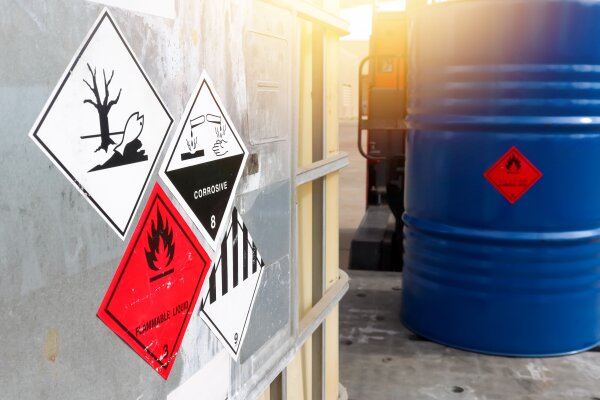Instruction for hazardous substances: everything on the subject

If hazardous substances are used in the company, prior instruction is mandatory. The law requires both instructions in the form of operatinginstructions and verbal instruction – so that all employees are well prepared for the necessary protective measures. We have summarized the contents that must be covered in an instruction for hazardous substances, how the legal requirements look like and what the most important rules of the instruction are.
What does the instruction for hazardous substances include?
When we talk about hazardous substances, we are talking about mixtures and substances that can have a harmful effect on people and/or the environment. This applies to production and/or use.
For this reason, such substances are not to be trifled with – anyone who is allowed to work with them must receive legally required hazardous substance training.
Hazardous substances training for employees must, according to § 14 para. 2 of the Ordinance on Hazardous Substances (GefStoffV) consist of written operating instructions and verbal instruction:
Instruction by operating manual
In accordance with § 14 of the Ordinance on Hazardous Substances (GefStoffV), the most important maxims for handling hazardous substances are recorded in writing in the operating instructions. It must be accessible to any employee who may be in potential contact with the substances and chemicals.
In particular, the possible hazards from the previous risk assessment must be evident in it. In addition, there areinstruction areas, hazardous substance designations, hazards to humans and/or the environment, and protective measures and rules of conduct. Instructions on what to do in the event of danger and information on first aid and proper disposal must also be visible.
Oral training
In accordance with § 14 of the Ordinance on Hazardous Substances (GefStoffV), the most important maxims for handling hazardous substances are recorded in writing in the operating instructions. It must be accessible to any employee who may be in potential contact with the substances and chemicals.
In particular, the possible hazards from the previous risk assessment must be evident in it. In addition, there areinstruction areas, hazardous substance designations, hazards to humans and/or the environment, and protective measures and rules of conduct. Instructions on what to do in the event of danger and information on first aid and proper disposal must also be visible.
Contents of the oral instruction for hazardous substances
At the same time, the contents of the oral instruction for hazardous substances are also quite strictly prescribed. This not only applies to the protection of employees and the knowledge of preventive measures, but additionally extends to legal aspects. This mandatory oral training, which is in addition to the operating instructions, must primarily cover the following topics:
Possible effect of hazardous substances (environment, body, physical)
Everyone who handles hazardous substances needs to know the health, physical and environmental risks of the substances – practically in their sleep. This is the only way to take appropriate protective measures in the event of an emergency. At the same time, with this knowledge, the correct precautions can be taken with regard to labeling, storage, reaction with other substances and transportation.
Definition of hazardous substances
According to the GefStoffV, hazardous substances are substances and mixtures that have a harmful effect on humans and/or the environment during manufacture and/or use. In addition, Section 3a of the Chemicals Act refers to Regulation (EC) No. 1272/2008, which specifies further criteria. The hazardous properties of substances, articles and mixtures must be made known to employees.
Correct performance of a risk assessment
The Technical Rules for Hazardous Substances (TRGS) contain further announcements and resolutions that must be discussed in the oral instruction. The 400 series specifies how the risk assessment is to be carried out – this determines which instructions and notes must be included in the operating instructions.
Procedure of a risk assessment
At the same time, series 400 of the TRGS gives the correct procedure of a risk assessment, which must be known to the employees. The process consists of information on working with hazardous substances (for example, according to the DaMaRIS hazardous substances directory), hazard identification, a substitution check to avoid hazards, and the definition of measures for working safely with the hazardous substances. In addition, it must be examined whether these measures are permanently sufficient.
Ranking of the protective measures (TOP)
The STOP principle is understood to be an order of priority that relates to the operational handling of protective measures. Thus, it should first be checked whether a substitution (“S”) with a less hazardous substance is possible. If not, technical (“T”), organizational (“O”) and personal (“P”) protective measures must be taken. These can consist, for example, of an extraction system, operating instructions and personal protective clothing.
Routes of absorption of hazardous substances (ingestion, inhalation, skin absorption, injection)
Depending on the hazardous substance, the routes of absorption into the body may differ, resulting in different routes of exposure. In the hazardous materials training for employees, all these ways must be mentioned and specifically designed for the substances at hand. The main routes of absorption include ingestion (liquids, dusts and solids), inhalation (gases, vapors, dusts, aerosols and soot) and skin absorption (liquids, gases and dusts). Injection may also be possible.
Legal classification of hazardous substances (national and international)
In addition, the legal basis for dealing with hazardous substances must be addressed – both nationally and internationally. These include, in particular, the Hazardous Substances Ordinance (GefStoffV), the Technical Regulations (TRGS), the Chemicals Act and the REACH Regulation (EU Regulation No. 1907/2006, Registration, Evaluation, Authorization and Restriction of Chemicals) on the German side, and the Globally Harmonized System (GHS) and the CLP Regulation on the international side.
Labeling of hazardous substances
Information on the labeling of hazardous substances is an important cornerstone for the training of employees in hazardous substances – after all, this aspect is encountered by the relevant persons time and again in their daily work. Here, too, national and international aspects come into play, which may relate to storage and transport.
Instruction for hazardous substances must therefore include the GHS symbols (Globally Harmonized System of Classification and Labeling of Chemicals), the H-phrases and P-phrases (concise, three-digit identification numbers within the GHS system) and signal words (“Danger” and “Caution” together with pictogram).
Safety Data Sheet
In addition to the operating instructions, a safety data sheet must be prepared for each hazardous substance. This must always be kept up to date and contain all essential information on the substances and on health, safety and protection. While it does not have to be in paper form, it must be permanently available to each employee.
The basis is the REACH regulation, which also specifies all 16 necessary sections. These range from substance names and first aid measures to fire-fighting, toxicological information, legal regulations and disposal instructions.
First aid measures
Speaking of first aid measures – these must of course also be covered in the instruction for hazardous substances. They focus on precautions for emergencies and align measures with exposure pathways. This includes, in particular, the accessibility of first responders, the locations of emergency showers and eyewash facilities, and the location and contents of the first aid kit). Employees should also be taught that symptoms may not appear for hours and that prudent and situational action should be taken.
Fire fighting measures
The fifth section of the MSDS deals with firefighting in the event of an emergency, which should be an elementary cornerstone in hazardous materials instruction. This includes information on the suitable (and unsuitable!) extinguishing agents for the respective hazardous substances as well as instructions for fire fighting.
In addition, attention must be drawn to special hazards, which may include, for example, the generation of toxic fumes, the bursting of containers and receptacles, and threatening chemical reactions.
Storage and warehousing
Hazardous substances are subject to special requirements for storage and warehousing that relate to the respective substance properties and prevent unintentional release. Consequently, the hazardous substances training for employees must also cover this aspect. This must include, in particular, handling in the workplace, distinctive labeling and the need for safety cabinets.
Limits and protective equipment
Limit values refer to maximum substance concentrations that may be found in the air, blood or urine, for example. Compliance is an essential part of the protective measures, so employees must be aware of all Occupational Exposure Limits (OELs), Biological Limit Values (BELs), and Derived No-Effect Levels (DNELs).
In addition to monitoring these parameters, it usually becomes necessary to wear personal protective equipment (PPE), the components of which must be extensively informed. Depending on the type of hazardous substance, this may include protective gloves, eye protection, respiratory protection and protective clothing, which must of course be in working order and properly stored.
Environmental protection and disposal
Oral hazardous materials training for employees must also provide information on how to dispose of them legally, with a special emphasis on environmental protection. This is prescribed in sections 12 to 15 of the safety data sheet. Dieser Punkt umfasst Abfallvorschriften, Abfallschlüsselnummern und auch Fragen zur Lagerung größerer Mengen gefährlicher Stoffe.
Legal regulations on hazardous substances training for employees
The Hazardous Substances Ordinance not only specifies the content and necessity of an operating instruction including verbal instruction when working with hazardous substances, but also provides additional legal information. These mainly concern the Youth Employment Protection Act, the Maternity Protection Act and the question of how often hazardous substances instruction must be carried out:
Youth Employment Protection Act
According to the Youth Employment Protection Act (JArbSchG), the employer is obliged to inform young people about measures to prevent hazards and about accident and health hazards when handling hazardous substances. This must be done prior to the start of employment and in the event of significant changes in working conditions. In addition, the instruction on hazardous substances must be repeated every six months (instead of annually as is usually the case).
Maternity Protection Act
Separate requirements also apply under the Maternity Protection Act (MuSchG). There, Section 12 states that pregnant and breastfeeding womenmay not be exposed to working conditions or engage in activities that pose an irresponsible risk. The CLP Regulation (Annex I) specifically mentions substances toxic to reproduction and lead and lead derivatives.
Therefore, the employer is obliged to assess the working conditions with regard to these aspects and to make any risk to pregnant and breastfeeding women known to all employees. This may include, for example, separate training for appropriate female employees.
How often must the instruction take place?
As briefly mentioned earlier, one-time hazardous materials training for employees is not sufficient. Instead, instruction for hazardous substances must berepeated regularly to keep knowledge fresh and to comply with legal requirements. In principle, the instruction on hazardous substances must be carried out at least once a year. In addition, a new repetition is prescribed on the following occasions:
- Taking up an activity in which hazardous substances are worked with directly or indirectly
- Introduction of new processes
- Use of new work equipment
- Use of new hazardous substances
- Changes in regulations regarding hazardous substances
The most important rules in the instruction for hazardous substances
Instruction for hazardous substances is required by law in every companywhere such substances, mixtures or products are worked with. There are several legal bases for this.
In addition to written operating instructions and detailed safety data sheets, hazardous substance instruction must also be provided verbally – this serves to provide your employees with optimum information. In addition, the following rules should always be remembered:
- Labels must always be legible and attached to the container
- Illegible labels must be replaced or reported
- Each container must be properly labeled – therefore, care must be taken when decanting
FAQ
Hazardous material instruction must be provided in the company both in writing and verbally. Therefore, both the operating instructions and the regular verbal instruction are decisive. The basis for this is the Ordinance on Hazardous Substances (GefStoffV).
The instruction for hazardous substances always takes place when a corresponding activity is started. The same applies to changes in regulations or when new processes, work equipment or hazardous working materials are introduced. It must be repeated at least annually.
What applies to instruction for hazardous substances must also be applied to operating instructions. This must be made clear to employees before they start work and when regulations are changed or work equipment, procedures and hazardous substances are introduced. It should be retrained annually so that everyone is on the same page.
Although the GefStoffV obliges the employer to record risks and take protective measures, the appointment of a hazardous substances officer is not part of this by law – nevertheless, this function can be worthwhile. Persons in the company who have taken part in further training to acquire the relevant specialist knowledgeare eligible to act as hazardous substances officers.
Do you have questions about the topic or would you like to suggest a topic? Please contact us by phone at +49 30 2096579 00 or send us an email at info@medsolut.com.




